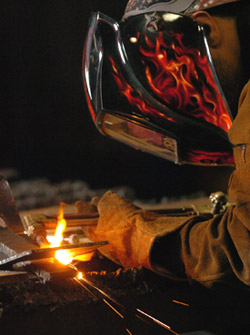 Welding Categories
Welding Categories  Gas Welding
Gas WeldingGas Welding
Gas welding, is also known as tungsten inert gas (TIG) welding. This is an arc welding process that uses a nonconsumable tungsten electrode to produce the weld. The weld area is sheltered from atmospheric contamination by a shielding gas is usually an inert gas welding such as filler, and a argon metal is normally used. Though some welding is also known as autogenous welds, do not need it. The constant-current welding power supply produces energy which is conducted across the arc through a column of highly metal vapors and ionized gas known as a plasma.
 | Gas tungsten arc welding is most generally used to weld thin sections of stainless steel and light metals such as aluminum, magnesium, and copper alloys. The process grants the worker better control over the weld than challenging procedures such as shielded metal arc welding and gas metal arc welding, allowing for stronger, higher quality welds. GTAW is relatively more complex and difficult to master, and furthermore, This Welding process is significantly slower than most other welding techniques. A related process is a plasma arc welding, uses a little different welding torch to create a extra focused welding arc and as a result is frequently automated. |
Operation On GasWelding:
Manual gas tungsten arc welding is regularly considered the most difficult of all the welding processes commonly used in welding industry. Because the gas welder must keep up a small arc length, grand care and skill are required to stop contact between the workpiece and the electrode. This gas welding is similar to torch welding, GTAW normally requires two hands, since the majority applications require that the welder yourself feed a filler metal into the weld area with one hand while manipulating the welding torch in the other hand. Some gas welds combining thin materials such as autogenous or fusion welds can be skilled without filler metal; most notably edge, corner, and butt joints.
To hit the welding arc, a high frequency generator is similar to a Tesla coil provides a spark; This spark is a conductive path for the welding present through the shielding gas and allows the arc to be initiated while the workpiece and the electrode are separated, typically about 1.5–3 mm and 0.06–0.12 in apart. This high voltage, high frequency break open can be damaging to a few vehicle electrical systems and electronics, because induced voltages on vehicle wiring can also effect small conductive sparks in the vehicle wiring or within semiconductor packaging. Vehicle 12V power may conduct crossways these ionized paths, driven by the high-current 12V vehicle battery. These currents can be suitably unhelpful as to disable the vehicle; thus the warning to cut off the vehicle battery power from both +12 and ground before using welding equipment on vehicles.
An exchange way to start the arc is the "scratch start". Scratching the electrode against the work with the power on also serve up to strike an arc welding, in the same way as SMAW ("stick") arc welding. Scratch starting can cause contamination of the welding and electrode. Some GTAW equipment is capable of a mode called "touch start" or "lift arc"; here the equipment decreases the voltage on the electrode to only a few volts, with a current limit of one or two amps (well under the limit that causes of effect metal to relocate and contagion of the weld or electrode). When the GTAW equipment detects that the electrode has left the surface and a sparkle is here, it immediately (within microseconds) increases power, converting the spark to a full arc.
Once the curve is struck, the welder moves the torch in a little circle to create a welding pool, the size of which depends on the size of amount of the current and electrode. While maintaining a constant separation between the workpiece and the electrode, the operator then moves the torch back a little and tilts it toward the back about 10–15 degrees from vertical. Filler metal has added yourself to the front end of the weld pool as it is needed.
Welders frequently expand a technique of quickly alternating between moving the torch frontward (to advance the weld pool) and adding filler metal. The filler rod is withdrawn from the weld pool each time the electrode advances, but it is never removed from the gas shield to stop oxidation of its face and contagion of the weld. Filler rods composed of metals with low down melting temperature, such as aluminum, need that the operator maintain some remoteness from the arc while staying inside the gas shield. If held too close to the arc welding, the filler rod can melt before it makes get in touch with the weld puddle. As the weld nears completion, the arc current is frequently reduced to allow the weld crater to solidify and stop the formation of crater cracks at the end of the weld.
